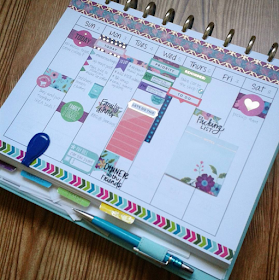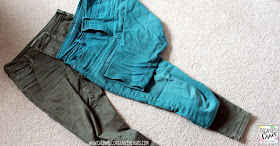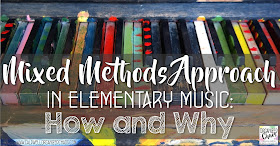I am pretty active in my classroom, as most elementary music teachers are. Within any given day, I need to have clothes that will allow me to dance, sit on the floor, interact with pre-teen boys, sing, conduct, play instruments (including some that go between my legs), and be comfortable in lots of different temperatures (because does anyone actually have a classroom where the temperature control is reliable???). For all you newer teachers looking to invest in some "professional" clothes, I wanted to share my tips for clothing that will work best in the demands of an elementary music teaching job.
Let me start by saying I am not a stylish person. If you want fashion tips to flatter your body, look good, or stay on top of the trends, you'll have to talk to someone else. But one thing I will say about my clothing choices: I am a very practical person. So please, take these recommendations and adapt them to your own style!
Here are some essentials that I think every elementary music teacher should have in their closet:
1. Layering Pieces
As I mentioned in the beginning of this post, temperatures tend to fluctuate in my classroom. Different parts of the school building are also drastically different temperatures, and I usually have some lessons where I'm moving around a lot and others where I'm less active, so my body temperature fluctuates too. I think the most important thing teachers need in their wardrobe is layers!
My 2 favorite types of layering pieces are camisoles and button-up sweaters. Camisoles are awesome because they add an extra layer under clothes that you otherwise may not be comfortable wearing to teach, like loose, low-neckline, or shorter length tops, and they don't add too much bulk if you want to add a layer without getting too hot. The best part about the camisoles that I have, though, is the length.
Whatever you do, you need to have tops that are long enough when you teach music!
Inevitably you are going to need to raise your arms up over your head repeatedly as a music teacher, whether you're conducting, dancing, or just going up the solfege ladder. Long camisoles are great because they're relatively cheap, and then you don't have to worry as much about the length of your existing tops because you can always add a camisole underneath!
The sweaters are pretty self-explanatory but definitely equally important for a teacher's wardrobe in my mind. I seriously take my sweaters on and off multiple times on any given day because of the temperature fluctuations! Having something that buttons in the front is MUCH better than something you have to pull over your head, not only because you won't mess up your hair or get tangled up with your lanyard/jewelry, but also because you don't have to stop teaching to take it on or off.
Sidenote: if you want to be able to layer effectively, you need to be able to mix and match clothes. But don't think you have to stick to just neutrals or a couple of colors to be able to mix and match everything! Just pick a color palette you like and stick to that RANGE of colors. That might be "earthy" tones, jewel tones, pastels, primary colors, etc. Like I said, I'm no style expert, but there's a little tip for you that helps me a lot when I'm thinking about how to layer different items together! ;)
2. Pants
There are 2 main reasons I think all elementary music teachers need pants, no matter how feminine your style normally might be: sitting on the floor and playing instruments that go between your legs. I've found some ways around needing pants to sit on the floor (see below), but if I'm leading a
drumming circle (or playing another instrument like a cello), I absolutely think the only option is to wear pants.
Because I think long tops are a must, like I mentioned before, I personally stick to skinny style pants that I think look better under long tops. Thankfully those are in style right now so that works in my favor- there are plenty of great options for where to get them! I try to have a few different colors in full-length pants and capris.
Another sidenote: yes, I know that a lot of my clothes look wrinkled.... I pulled a few out of storage or the laundry basket to take pictures, and some of them just don't lay flat on the floor.....
3. Skirts and Dresses
I used to hardly ever wear skirts or dresses to work because I didn't feel like I could move freely or comfortably sit on the floor, but I've figured out that with the right kind of skirt I can comfortably wear them for teaching too, which makes me so happy! For me, the key is to get fuller, knee-length skirts, preferably with pockets. Too short and you have obvious issues with sitting on the floor, too long and you can't move around as freely. Once I found a couple of options I liked, I bought them in at least 2 different colors because this combination is so hard to find! In any case though, I make sure to wear leggings underneath, so I guess another wardrobe essential for me is leggings in a few different lengths and weights (thicker and longer for winter, thinner capri length or shorter for warmer months).
4. Shoes
Shoes. Probably the biggest dilemma for a lot of people, since we're on our feet so much! No, I don't have a magic answer for this. I will definitely say that flats are a must for me- I stopped wearing heels of all kinds years ago- and currently my favorite shoes are Toms because they are comfortable and breathe well, but the main thing I'll say about shoes is to experiment, find a pair of shoes that are really comfortable, and stock up on them in multiple colors. If you can find a pair of shoes that you love wearing, that is a magical thing that you'll want to hold onto as long as you can!
5. Tops
My favorite tops to wear to school with pants or skirts are
1) loose-fitting enough to allow movement
2) long enough so I can raise my arms over my head without showing off my midriff or can be worn over a camisole
3) short sleeves or long sleeves that can easily be pushed up if I need to
4) thin enough to be worn with layers over and/or under
5) not too low-cut of a neckline or can be worn over a camisole
I think my list is pretty self-explanatory based on the points I already talked about with layering pieces and bottoms, so I won't rehash those points here, but I will say that my current favorite type of top is the tunic top. They have 3/4 length sleeves that I can easily push up if I get hot, and they fit loosely so I can wear a camisole underneath and move freely.
6. Performance outfits
Most every music teacher is going to need some dressier clothes to wear for concerts and performances! I'm a traditionalist- I stick with all black most of the time for concerts. But the same general rules for work clothing apply to concerts too- I need layers, I need to be able to stand and sit in the clothes comfortably, and I need to be able to move freely and raise my arms up comfortably for conducting. I have a couple of black dresses, black pants, and a black top so I can have a bit of variety in what I wear to different performances.
Outfit examples
Now that I've talked a little about my teacher wardrobe essentials, here are some examples of some of my personal favorites to give you an idea of what I wear to school on a typical day:
I hope you found this post helpful- I feel weird talking about fashion but it took me a while to figure out what I could and couldn't practically wear to teach in as an elementary music teacher, so hopefully you found some useful tips to make it easier for you to find the right clothes for you.
Now it's your turn: what are your elementary music teacher wardrobe essentials??? Leave a comment below!
Get more timely tips sent straight to your inbox each month!
Click here to sign up for the Organized Chaos newsletter!



























































